Geography: June 2023 UPSC Current Affairs | Current Affairs & Hindu Analysis: Daily, Weekly & Monthly PDF Download
| Table of contents |

|
| Delayed Monsoon |

|
| Indian Ocean Dipole |

|
| Impact of Ground Water Extraction on Earth’s Spin |

|
| El Nino 2023: Unusual Warming Like 2009 |

|
| Mekedatu Dam Project |

|
| Shanan Power Project |

|
Delayed Monsoon
Why in News?
In 2023, the monsoon arrived over the Kerala coast on June 8, which is a delay compared to its normal onset date of June 1.
What is Monso on?
- About:
- Monsoons are seasonal winds (Rhythmic wind movements or Periodic Winds) which reverse their direction with the change of season.
- Factors Influencing South-West Monsoon:
- The differential heating and cooling of land and water creates a low pressure on the landmass of India while the seas around experience comparatively high pressure.
- The shift of the position of Inter Tropical Convergence Zone (ITCZ) in summer, over the Ganga plain (this is the equatorial trough normally positioned about 5°N of the equator.
- It is also known as the monsoon-trough during the monsoon season).
- The presence of the high-pressure area, east of Madagascar, approximately at 20°S over the Indian Ocean. The intensity and position of this high-pressure area affect the Indian Monsoon.
- The Tibetan plateau gets intensely heated during summer, which results in strong vertical air currents and the formation of low pressure over the plateau at about 9 km above sea level.
- The movement of the westerly jet stream to the north of the Himalayas and the presence of the tropical easterly jet stream over the Indian peninsula during summer.
- Southern Oscillation (SO):
- It is a shift in wind and sea surface temperature between the tropical eastern Pacific Ocean and the Indian Ocean. It is commonly referred to as the phenomenon of shifting air pressure.
- La Nina is the cooling phase, and El Nino is the warming phase.
- La Nina generally impacts positively on Indian Monsoon.
- Indian Ocean Dipole (IOD):
- IOD is the difference between the temperature of eastern (Bay of Bengal) and the western Indian Ocean (Arabian Sea).
- A positive IOD brings more rainfall in India while negative IOD impacts negatively.
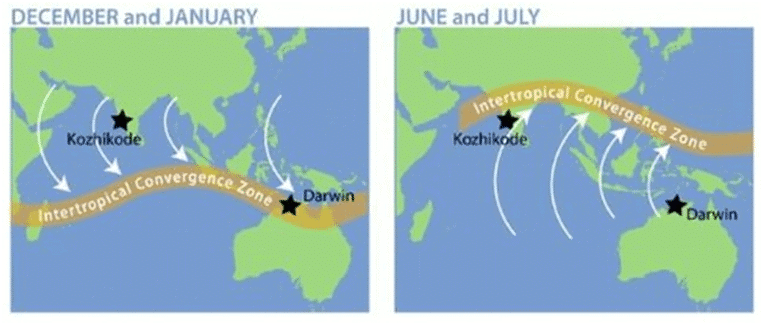
What is the Onset of Monsoon?
- Monsoon Onset:
- The onset of the monsoon over the Kerala coast signifies the start of the four-month southwest monsoon season, which accounts for over 70% of India's annual rainfall.
- Contrary to common assumptions, the onset does not refer to the first rain of the season but rather follows specific technical criteria set by the India Meteorological Department (IMD).
- Conditions for Monsoon Onset:
- The IMD determines the monsoon onset based on significant transitions in atmospheric and ocean circulations in the Indo-Pacific region.
- The declaration of onset relies on specific parameters related to rainfall consistency, intensity, and wind speed.
- Rainfall:
- The onset is declared when at least 60% of 14 designated meteorological stations in Kerala and Lakshadweep record at least 2.5 mm of rain for two consecutive days after May 10.
- The onset is declared on the second day if specific wind and temperature criteria are met.
- Wind Field:
- The depth of westerlies within the equator to 10ºN latitude and the 55ºE to 80ºE longitude range should extend up to 600 hectopascal (hPa).
- The zonal wind speed between 5-10ºN latitude and 70-80ºE longitude should be around 15-20 knots (28-37 kph) at 925 hPa.
- Heat:
- The Outgoing Longwave Radiation (OLR) value, derived from INSAT, should be below 200 watt per sq m (wm2) in the area between 5ºN and 10ºN latitudes and 70ºE and 75ºE longitudes.
Impact of Delayed Onset
- Agriculture:
- Delayed monsoon onset can affect agricultural activities, particularly sowing of crops.
- Farmers heavily rely on monsoon rains for irrigation and crop growth.
- A delay in rainfall can lead to a postponement of sowing, affecting crop yields and agricultural productivity.
- Water Resources:
- Delayed monsoon onset can result in water scarcity, especially in regions dependent on rainfall for replenishing water reservoirs, rivers, and lakes.
- Energy Sector:
- Delayed monsoon can impact hydropower generation, which relies on sufficient water availability.
- Environment:
- It can affect the growth and distribution of vegetation, delay the migration of certain species, and disrupt ecological cycles.
- Delayed monsoon can also contribute to soil erosion, land degradation, and reduced biodiversity in affected regions.
Indian Ocean Dipole
Why in News?
The Indian Monsoon is expected to be influenced by the El Nino phenomenon in 2023, there are also anticipations of a positive Indian Ocean Dipole (IOD) developing, which could potentially offset the impact of El Nino.
- According to the India Meteorological Department (IMD), there is about 80% probability for positive IOD conditions and 15% of a neutral IOD during June-August 2023 season.
- While the El Nino is already firmly established in the Pacific Ocean in 2023, the IOD is still in the neutral phase and may develop in the coming months.
What is the Indian Ocean Dipole (IOD)?
- IOD or Indian Nino:
- IOD, sometimes referred to as the Indian Nino, is similar to the El Nino phenomenon, occurring in the relatively smaller area of the Indian Ocean between the Indonesian and Malaysian coastline in the east and the African coastline near Somalia in the west.
- The El Nino is the warmer-than-normal phase of the El Nino Southern Oscillation (ENSO) phenomenon, during which there are generally warmer temperatures and less rainfall than normal in many regions of the world, including India.
- One side of the ocean, along the equator, gets warmer than the other.
- IOD is said to be positive when the western side of the Indian Ocean, near the Somalia coast, becomes warmer than the eastern Indian Ocean.
- It is negative when the western Indian Ocean is cooler.
- IOD, sometimes referred to as the Indian Nino, is similar to the El Nino phenomenon, occurring in the relatively smaller area of the Indian Ocean between the Indonesian and Malaysian coastline in the east and the African coastline near Somalia in the west.
- Mechanism:
- Negative IOD:
- The air circulation in the Indian Ocean basin moves from west to east, that is from the African coast towards the Indonesian islands, near the surface, and in the opposite direction at the upper levels. That means the surface waters in the Indian Ocean get pushed from west to east.
- In a normal year, warmer waters in the western Pacific near Indonesia cross over into the Indian Ocean and make that part of the Indian Ocean slightly warmer. That causes the air to rise and helps the prevailing air circulation.
- In the years when the air circulation becomes stronger, more warm surface waters from the African coast are pushed towards the Indonesian islands, making that region warmer than usual. This causes hotter air to rise, and the cycle reinforces itself.
- This is the state of negative IOD.
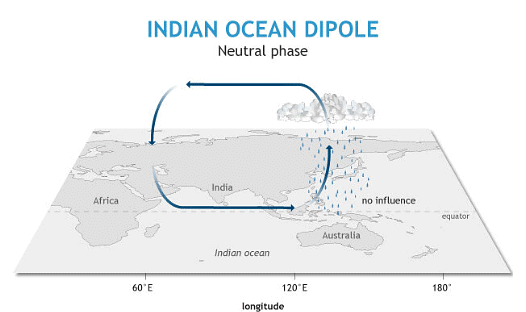
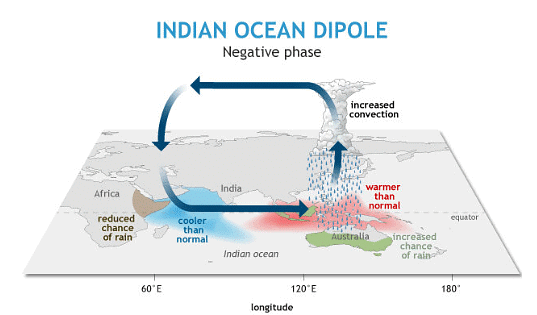
- Positive IOD:
- Air circulation becomes slightly weaker than normal. In some rare cases, the air circulation even reverses direction. The consequence is that the African coast becomes warmer while the Indonesian coastline gets cooler.
- A positive IOD event is often seen developing at times of an El Nino, while a negative IOD is sometimes associated with La Nina.
- During El Nino, the Pacific side of Indonesia is cooler than normal because of which the Indian Ocean side also gets cooler. That helps the development of a positive IOD.
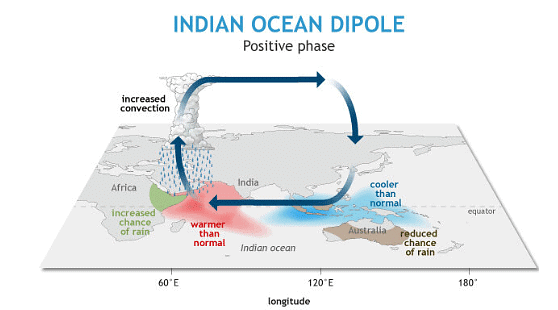
- Impact of IOD:
- In the Indian Ocean, IOD exhibits an ocean-atmosphere interaction that closely resembles the fluctuations observed during El Niño events in the Pacific Ocean. However, the IOD is considerably less powerful compared to El Niño, resulting in relatively minimal impacts.
- A positive IOD helps rainfall along the African coastline and also over the Indian sub-continent while suppressing rainfall over Indonesia, southeast Asia and Australia. The impacts are opposite during a negative IOD event.
- Past Events:
- In 2019 the IOD event developed during the late monsoon but was so strong that it compensated for the deficit rainfall during the first month of the monsoon season (June had 30% deficiency that year).
- The deficit in June that year was also attributed to a developing El Nino but that fizzled out later.
- In 2019 the IOD event developed during the late monsoon but was so strong that it compensated for the deficit rainfall during the first month of the monsoon season (June had 30% deficiency that year).
Impact of Ground Water Extraction on Earth’s Spin
Context
Recently, a study was published in the ‘Geophysical Research Letters’ which has highlighted the impact of high groundwater extraction on earth's rotational axis and its overall contribution to global sea-level rise.
Some Key Findings of the Study are
- As per the study, pumping of groundwater has tilted the earth by almost 80 cm east between the year 1993 and 2010 alone.
- The water circulated across the earth determines how mass is distributed and it has been found that between the year 1993 and 2010, people extracted almost 2,200 gigatons of groundwater.
- High groundwater extraction has caused the earth's pole to drift at a rate of 4.3 cm’s per year between the year 1993 and 2010 which makes it the climate-related factor having highest impact on polar motion.
- The study also found that high groundwater extraction contributed to a sea-level rise of almost 6.2 mm.
- The study also recommended to increase efforts to slow groundwater depletion, especially in the sensitive regions.
What are the Factors Affecting Earth's Rotation?
- Conservation of angular momentum: As the Earth formed from a rotating cloud of gas and dust, its rotation rate was established by the conservation of angular momentum. The collapse of this cloud caused it to spin faster due to the conservation of this property.
- Distribution of mass: The distribution of mass within the Earth affects its rotation. Variations in the mass distribution, such as the presence of continents, mountains, and oceanic trenches, can cause slight changes in the rotation rate. Large-scale movements of mass, such as the melting of glaciers or the redistribution of water in the oceans, can also impact the rotation rate.
- Tidal forces: The gravitational pull of the Moon and the Sun creates tidal forces on Earth. These forces cause bulges in the oceans and deformations on the Earth's surface, leading to friction and transfer of angular momentum between the Earth and the Moon-Sun system. As a result, the Earth's rotation slows down slightly over time.
- Atmospheric and oceanic circulation: The movement of air masses in the atmosphere and water currents in the oceans can influence the Earth's rotation. Changes in atmospheric pressure, wind patterns, and ocean currents can cause redistribution of mass and affect the rotation rate.
- Earthquakes and tectonic activity: Significant earthquakes and tectonic events can cause localized shifts in mass distribution, which can alter the Earth's rotation. However, the effect of individual seismic events is generally negligible on a global scale.
- Glacial isostatic adjustment: The melting and formation of large ice sheets during glacial periods can cause significant changes in the Earth's rotation. As the ice melts, the land rebounds and redistributes mass, impacting the rotation rate.
Conclusion
It's important to note that while these factors can influence the Earth's rotation, their effects are relatively small and occur over long periods of time. The Earth's rotation is quite stable on human timescales.
El Nino 2023: Unusual Warming Like 2009
Why in News?
Recently, an unusual phenomenon is developing along the equatorial Pacific region, indicating the emergence of El Nino conditions in 2023. Experts warn that this simultaneous warming of the eastern and western regions of the equatorial Pacific, a trend last observed in 2009, could have severe implications for marine life worldwide.
What are the Causes for this Phenomenon?
- The eastern Pacific is getting warmer, which should make the west cooler.
- However, due to global warming, there is basin scale warming across the tropical Pacific.
- Two things could have triggered this phenomenon:
- Global warming in the Pacific and other modes of natural variability
- The transition from La Nina winter into an El Nino summer which is part of the El Nino-Southern Oscillation (ENSO) cycle.

What is ENSO?
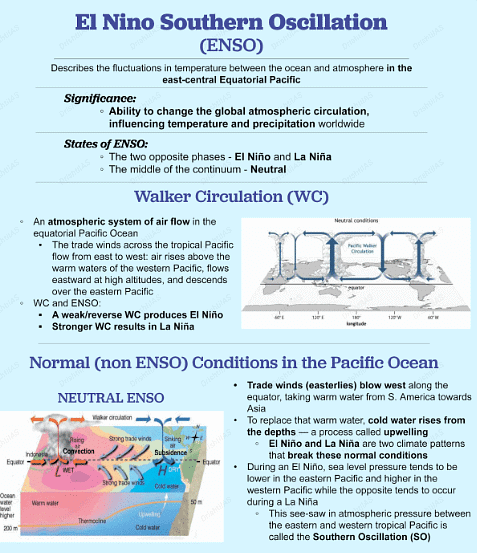
What are the Potential Consequences of this Phenomenon?
- Global Warming:
- The end of La Nina means that the ocean is not taking up heat, which will dissipate into the atmosphere.
- If the atmosphere is warmer, then the ocean doesn't lose as much heat, causing it to warm up at the surface.
- This may temporarily push global warming beyond 1.5°C.
- Geophysical Effect:
- The phenomenon will affect cyclones, hurricanes, and typhoons, with Typhoon Mawar in the western Pacific already being one of the strongest.
- The warming of ocean waters acts as a catalyst for marine heatwaves, the slowing of meridional circulation, which could cause unmitigable losses for marine biodiversity.
- Coral Bleaching:
- A warming of 1.5°C threatens to destroy 70 to 90 per cent of coral reefs, and a 2°C increase means a nearly 100 per cent loss – a point of no return.
What is the Impact El Nino 2023 on India?
- Weak Monsoon for India: The development of an El Nino in May or June 2023 may cause weakening of the southwest monsoon season, which brings around 70% of the total rainfall India receives and on which most of its farmers still depend.
- However, sub-seasonal factors such as the Madden-Julian Oscillation (MJO) and monsoon low-pressure systems can temporarily enhance rainfall in some parts as witnessed in the year 2015.
- Hot Temperatures: It may also cause heatwaves and droughts in India and other regions around the world such as South Africa, Australia, Indonesia and the Pacific Islands.
Mekedatu Dam Project
Context
New State government in Karnataka expressed Concern over the Mekedatu Dam Dispute. The government announced an Intention to resolve the dispute.
Details
- The Mekedatu dam project is a proposed multi-purpose balancing reservoir on the Cauvery River, near the border of Karnataka and Tamil Nadu.
- The project aims to provide drinking water to Bengaluru and Ramanagara districts, as well as generate hydroelectric power for Karnataka.
- However, the project has been opposed by Tamil Nadu, which claims that it will affect its share of water from the Cauvery River and violate the final order of the Cauvery Water Disputes Tribunal (CWDT) and the Supreme Court.
Cauvery River Dispute
- The Cauvery River is an inter-state river that originates in Karnataka and flows through Tamil Nadu, Kerala and Puducherry before joining the Bay of Bengal.
- The river has been a source of conflict between Karnataka and Tamil Nadu for decades, as both states depend on it for irrigation, drinking water and power generation.
Cauvery Water Disputes Tribunal (CWDT)
- The Cauvery Water Disputes Tribunal (CWDT) was set up in 1990 to adjudicate the dispute and allocate water among the four states.
- In 2007, the CWDT gave its final order, which was challenged by all states in the Supreme Court.
- In 2018, the Supreme Court upheld the CWDT order with some modifications and directed the central government to set up a Cauvery Water Management Authority (CWMA) to implement the order.
Mekedatu dam project
- The Mekedatu dam project was first proposed by Karnataka in 2013, with an estimated cost of Rs 5,912 crore and a capacity of 66 tmcft (thousand million cubic feet).
- Karnataka claimed that the project would not affect Tamil Nadu's water entitlement, as it would only store excess water after releasing it to Tamil Nadu as per the CWDT order. Karnataka also argued that the project would help regulate the water flow and prevent the wastage of water into the sea.
- However, Tamil Nadu objected to the project, alleging that it would reduce the natural flow of the river and deprive its farmers of irrigation water.
- Tamil Nadu also contended that Karnataka cannot construct any new project on the Cauvery River without its consent and clearance from the CWMA
Dispute over the Mekedatu Dam project
- The dispute over the Mekedatu dam project has escalated in recent years, with both states approaching the central government and the courts for their respective interests.
- In 2018, Karnataka sought permission from the central government to conduct a feasibility study for the project, which was granted by the Central Water Commission (CWC). Tamil Nadu challenged this decision in the Supreme Court, which stayed the feasibility study until further orders.
- In 2020, Karnataka submitted a detailed project report (DPR) to the CWC for approval, which was opposed by Tamil Nadu in a letter to the Prime Minister.
- In 2021, Karnataka announced its intention to start work on the project soon, which triggered protests by political parties and farmers' associations in Tamil Nadu.
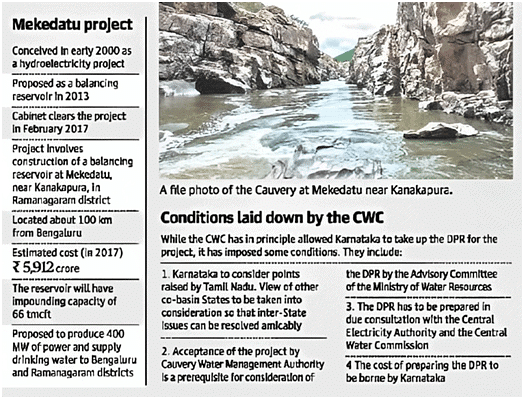
Way forward
- The Mekedatu Dam dispute is a complex and sensitive issue that involves legal, technical and political aspects. The dispute reflects the competing demands and interests of two states over a shared natural resource that is vital for their development and livelihoods.
- The dispute also poses a challenge to cooperative federalism and inter-state relations in India. The resolution of this dispute requires dialogue, negotiation and compromise among all stakeholders, based on scientific data, legal principles and equitable distribution of water.
Shanan Power Project
Context
The 99-year lease on the British-era 110 MW Shanan hydropower facility located near Jogindernagar in the Mandi district of Himachal Pradesh, which is currently under the jurisdiction of the Punjab Government, will end in March 2024.
Details
- The matter might escalate into a big dispute between the two neighbouring states, as the Himachal Pradesh government has stated that it will not renew or extend the lease.
- Himachal Pradesh wants the project turned over to the state after the lease time expires. The Punjab Government, on the other hand, is unwilling to give up its cherished project and is willing to go to court to save it.
Shanan Hydropower Project
- The Shanan hydropower project in the Mandi district of Himachal Pradesh is one of the oldest and most important hydroelectric projects in India. It was built by the British in 1925.
- The project harnesses the power of the Uhl River, a tributary of the Beas River, and generates 110 MW of electricity.
- The project consists of a dam, a powerhouse, a reservoir and a network of canals and tunnels. The project is also a source of irrigation and drinking water for the surrounding areas.
- The project was leased to the Punjab Government for 99 years by Raja Joginder Singh Bahadur, the then-ruler of Mandi state.
- The lease agreement will expire in March 2024, and both Himachal Pradesh and Punjab are claiming their rights over the project.
- Himachal Pradesh Chief Minister Sukhvinder Singh Sukhu has written to the Punjab Chief Minister and the Union Power Minister, stating that his government will not renew or extend the lease and wants the project to be handed over to the state.
- Punjab, however, is reluctant to give up the project and may seek legal recourse to retain it.
|
38 videos|5254 docs|1109 tests
|















